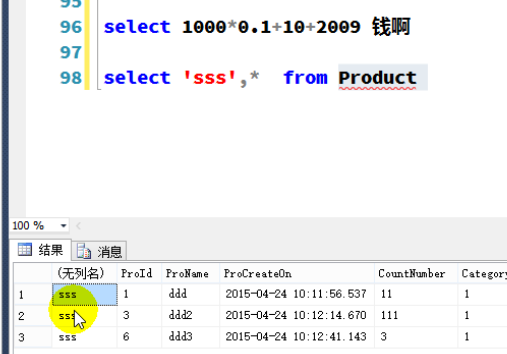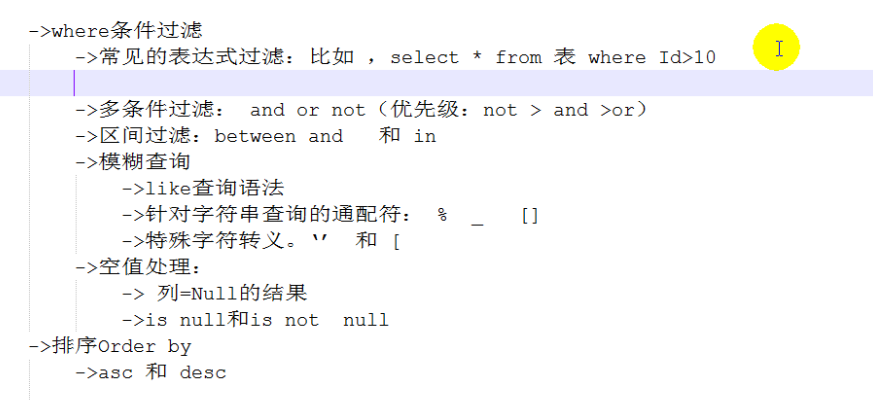sql03
1、约束
约束详解
->约束的目的:保证数据的完整性. not null ->默认值约束、可空约束、主键约束、外键约束、唯一键约束、检查约束
1) 用sql语句为表添加新的字段

2) 为字段添加默认值
alter table 表名 add constraint 约束名称(DF_表名_字段名) 约束方法 for 子段名;
alter table [dbo].[user] add constraint DF_user_age default(18) for age;
这里生成的约束可在“约束”内删除
3)删除某一字段
如果字段存在约束,需要先删除约束
alter table [dbo].[user] drop column birthdate;
4) 修改某一字段
alter table [dbo].[user] alter column [name] nvarchar(16);
5)主键约束
alter table 表名 add constraint 约束名称(PK_表名_字段名) primary key(字段名)
6)唯一键约束
alter table [user] add constraint UQ_user_name unique (name);
7)外键约束
一对一,一对多,多对多
外键表关联主键表的主键
添加外键列:
alter table [user] add ClassId int null;
--添加外键关系
alter table [user] add constraint FK_user_Class foreign key(ClassId) references Class(ClassId);
alter table 表名 add constraint 约束名 foreign key(关联字段) references 主键表名(主键表主键);
2、select 查询
1)其他用法:

添加自定义常数列:

找表中最短的列进行统计
select count(*) from [user];
查找表前5条数据
select top 5 * from [user];
*处可以用各个字段进行代替
3、聚合函数
1)平均值:avg
select avg(字段名1),,avg(字段名2)... from 表名;
select avg(age) from [user];
2)计数:count
select count(age) from [user];
3)求和与最值
select max(age) as 最大值,min(age) as 最小值,sum(age)as 和 from [user];
4、top
一般跟排序order连用
select top 5 * from [user] order by age asc,id desc;
asc升序,desc降序
5、去重distinct
select distinct [age] from [user] order by age asc;
distinct 只能跟在select后
如果distinct后跟多个字段,则系统会综合这几个字段进行去重

6、where 过滤
not 用<>进行表示
select * from [user] where age<>21;
7、区间过滤
可以用and解决
也可用between
select * from [user] where age between 20 and 50;
8、模糊查询

like 关键字
%:匹配任何多个字符(0~多个)
_:仅匹配1个字符
1)例1:查找名字以J开头的数据:
select * from [user] where [name] like 'J%';
2)例2:查找名字中包含a的数据‘’
select * from [user] where [name] like '%a%';
3)例3:查找名字中第4个字符为a的数据‘’
select * from [user] where [name] like '___a%';
4)例4,:查询内容中包含',两个单引号表示1个
select * from [user] where [name] like '%''%';
5) 查找包含数字的1到2
select * from [user] where [age] like '[1-2]%';
6)匹配一个左中括号
select * from [user] where [name] like '[[]%';
或者声明转义
select * from [user] where [name] like '\[%' escape '\';
7)查询空数据
select * from [user] where [age] is null;
可在is后加not表示非空
9、分组group
分组使用时在select后只能跟分组相关信息与聚合函数
select ClassId,count(*),sum(age) from [user] group by ClassId;
------------恢复内容结束------------
最新文章
- ThreadLocal内部机制及使用方法
- 不可或缺 Windows Native (25) - C++: windows app native, android app native, ios app native
- javascript栈的建立样码
- linux:指令与档案的搜索
- 不加班的实践(1)——这真的该用try-catch吗?
- Android ListFragment实例Demo(自己定义适配器)
- stat~~~访问文件状态的利器
- C语言实现界面(不通过MFC\避免遗忘)
- iphone手机上的click和touch
- ZUFE OJ 2145 05机关图
- nodejs服务实现反向代理,解决本地开发接口请求跨域问题
- [SCOI2007]降雨量
- 系列博文-Three.js入门指南(张雯莉)-照相机
- Python爬虫入门教程 35-100 知乎网全站用户爬虫 scrapy
- H5 notification浏览器桌面通知
- Bullet3的一些理解
- Pyhton2.x 和Python3.x
- SQL记录-PLSQL函数
- 转: wireshark的使用说明
- smali-2.2.4.jar & baksmali-2.2.4.jar